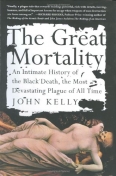BKMT READING GUIDES
The Great Mortality : An Intimate History of the Black Death, the Most Devastating Plague of All Time
by John Kelly
Hardcover : 384 pages
0 club reading this now
0 members have read this book
So begins, in almost fairy-tale fashion, a contemporary account of the worst natural disaster in European history -- what we call the Black Death, and what the generation who ...
Introduction
In October 1347, at about the start of the month, twelve Genoese galleys put in to the port of Messina [Italy].
So begins, in almost fairy-tale fashion, a contemporary account of the worst natural disaster in European history -- what we call the Black Death, and what the generation who lived through it called la moria grandissima: "the great mortality." The medieval plague, however, was more than just a European catastrophe. From the bustling ports along the China Sea to the fishing villages of coastal Greenland, almost no area of Eurasia escaped the wrath of the medieval pestilence. And along with people died dogs, cats, chickens, sheep, cattle, and camels. For a brief moment in the middle of the fourteenth century, the words of Genesis 7:21 seemed about to be realized: "All flesh died that moved upon the earth."
THE GREAT MORTALITY is John Kelly's compelling narrative account of the medieval plague, from its beginnings on the desolate, windswept steppes of Central Asia to its journey through the teeming cities of Europe. "This is the end of the world," wrote a bootblack of the pestilence's arrival in his native Siena. THE GREAT MORTALITY paints a vivid picture of what the end of the world looked like, circa 1348 and 1349: bodies packed like "lasagna" in municipal plague pits, collection carts winding through the streets early in the morning to pick up the dead, desperate crowds crouched over municipal latrines inhaling noxious fumes in hopes of inoculating themselves against the plague, children abandoning infected parents -- and parents, infected children. THE GREAT MORTALITY also looks at new theories about the cause of the plague and takes into account why some scientists and historians believe that the Black Death was an outbreak not of bubonic plague, but of another infectious illness -- perhaps anthrax or a disease like Ebola.
Interweaving a modern scientific methodical analysis with an evocative portrait of medieval medicine, superstition, and bigotry, THE GREAT MORTALITY achieves an air of immediacy, authenticity, and intimacy never before seen in literature on the plague. Drawing on the latest research, it unwraps the mystery that shrouds the disease and offers a new and fascinating look into the complex forces that went into the making of the Black Death.
A book chronicling one of the worst human disasters in recorded history really has no business being entertaining. But John Kelly's The Great Mortality is a page-turner despite its grim subject matter and graphic detail. Credit Kelly's animated prose and uncanny ability to drop his reader smack in the middle of the 14th century, as a heretofore unknown menace stalks Eurasia from "from the China Sea to the sleepy fishing villages of coastal Portugal [producing] suffering and death on a scale that, even after two world wars and twenty-seven million AIDS deaths worldwide, remains astonishing." Take Kelly's vivid description of London in the fall of 1348: "A nighttime walk across Medieval London would probably take only twenty minutes or so, but traversing the daytime city was a different matter.... Imagine a shopping mall where everyone shouts, no one washes, front teeth are uncommon and the shopping music is provided by the slaughterhouse up the road." Yikes, and that's before just about everything with a pulse starts dying and piling up in the streets, reducing the population of Europe by anywhere from a third to 60 percent in a few short years. In addition to taking readers on a walking tour through plague-ravaged Europe, Kelly heaps on the ancillary information and every last bit of it is captivating. We get a thorough breakdown of the three types of plagues that prey on humans; a detailed account of how the plague traveled from nation to nation (initially by boat via flea-infested rats); how floods (and the appalling hygiene of medieval people) made Europe so susceptible to the disease; how the plague triggered a new social hierarchy favoring women and the proletariat but also sparked vicious anti-Semitism; and especially, how the plague forever changed the way people viewed the church. Engrossing, accessible, and brimming with first-hand accounts drawn from the Middle Ages, The Great Mortality illuminates and inspires. History just doesn't get better than that. --Kim Hughes
Discussion Questions
No discussion questions at this time.Book Club Recommendations
Recommended to book clubs by 0 of 0 members.
Book Club HQ to over 90,000+ book clubs and ready to welcome yours.
Get free weekly updates on top club picks, book giveaways, author events and more








